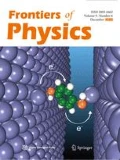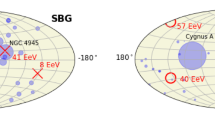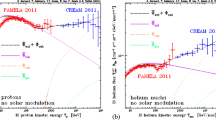Abstract
Precise measurements of the energy spectra of cosmic rays (CRs) show various kinds of features deviating from single power-laws, which give very interesting and important implications on their origin and propagation. Previous measurements from a few balloon and space experiments indicate the existence of spectral softenings around 10 TV for protons (and probably also for Helium nuclei). Very recently, the DArk Matter Particle Explorer (DAMPE) measurement about the proton spectrum clearly reveals such a softening with a high significance. Here we study the implications of these new measurements, as well as the groundbased indirect measurements, on the origin of CRs. We find that a single component of CRs fails to fit the spectral softening and the air shower experiment data simultaneously. In the framework of multiple components, we discuss two possible scenarios, the multiple source population scenario and the background plus nearby source scenario. Both scenarios give reasonable fits to the wide-band data from TeV to 100 PeV energies. Considering the anisotropy observations, the nearby source model is favored.
Similar content being viewed by others
References
M. Aguilar, et al., Precision measurement of the boron to carbon flux ratio in cosmic rays from 1.9 GV to 2.6 TV_with the alpha magnetic spectrometer on the international space station, Phys. Rev. Lett. 117(23), 231102 (2016)
A. D. Panov, et al., Energy spectra of abundant nuclei of primary cosmic rays from the data of ATIC-2 experiment: Final results, Bull. Russ. Acad. Sci. Phys. 73(5), 564 (2009), arXiv: 1101.3246
H. S. Ahn, et al., Discrepant hardening observed in cosmic-ray elemental spectra, Astrophys. J. 714(1), L89 (2010), arXiv: 1004.1123
O. Adriani, et al., PAMELA measurements of cosmic-ray proton and helium spectra, Science 332(6025), 69 (2011), 1103.4055
M. Aguilar, et al., Precision measurement of the proton flux in primary cosmic rays from rigidity 1 GV to 1.8 TV with the alpha magnetic spectrometer on the international space station, Phys. Rev. Lett. 114(17), 171103 (2015)
M. Aguilar, et al., Precision measurement of the helium flux in primary cosmic rays of rigidities 1.9 GV to 3 TV with the alpha magnetic spectrometer on the international space station, Phys. Rev. Lett. 115(21), 211101 (2015)
M. Aguilar, et al., Observation of the Identical Rigidity Dependence of He, C, and O cosmic rays at high rigidities by the alpha magnetic spectrometer on the international space station, Phys. Rev. Lett. 119(25), 251101 (2017)
O. Adriani, et al., Direct measurement of the cosmic-ray proton spectrum from 50 GeV to 10 TeV with the calorimetric electron telescope on the international space station, Phys. Rev. Lett. 122, 181102 (2019), arXiv: 1905.04229
Y. Ohira and K. Ioka, Cosmic-ray helium hardening, Astrophys. J. 729(1), L13 (2011), arXiv: 1011.4405
Q. Yuan B. Zhang and X. J. Bi, Cosmic ray spectral hardening due to dispersion in the source injection spectra, Phys. Rev. D 84(4), 043002 (2011), arXiv: 1104.3357
A. E. Vladimirov G. Jóhannesson I. V. Moskalenko and T. A. Porter, Testing the origin of high-energy cosmic rays, Astrophys. J. 752(1), 68 (2012), arXiv: 1108.1023
A. D. Erlykin and A. W. Wolfendale, A new component of cosmic rays? Astropart. Phys. 35(7), 449 (2012)
S. Thoudam and J. R. Hörandel, Nearby supernova remnants and the cosmic ray spectral hardening at high energies, Mon. Not. R. Astron. Soc. 421(2), 1209 (2012), arXiv: 1112.3020
G. Bernard T. Delahaye Y.-Y. Keum W. Liu P. Salati and R. Taillet, TeV cosmic-ray proton and helium spectra in the myriad model, Astron. Astrophys. 555, A48 (2013), arXiv: 1207.4670
W. Liu X.-J. Bi S.-J. Lin B.-B. Wang and P.-F. Yin, Excesses of cosmic ray spectra from a single nearby source, Phys. Rev. D 96, 023006 (2017), arXiv: 1611.09118
V. Ptuskin V. Zirakashvili and E. S. Seo, Spectra of cosmic-ray protons and helium produced in supernova remnants, Astrophys. J. 763(1), 47 (2013), arXiv: 1212.0381
S. Thoudam and J. R. Hörandel, GeV-TeV cosmic-ray spectral anomaly as due to reacceleration by weak shocks in the galaxy, Astron. Astrophys. 567, A33 (2014), arXiv: 1404.3630
Y. Zhang S. Liu and Q. Yuan, Anomalous distributions of primary cosmic rays as evidence for time-dependent particle acceleration in Supernova remnants, Astrophys. J. Lett. 844, L3 (2017), arXiv: 1707.00262
N. Tomassetti, Origin of the cosmic-ray spectral hardening, Astrophys. J. 752(1), L13 (2012), 1204.4492
P. Blasi E. Amato and P. D. Serpico, Spectral breaks as a signature of cosmic ray induced turbulence in the galaxy, Phys. Rev. Lett. 109(6), 061101 (2012), 1207.3706
N. Tomassetti and F. Donato, The connection between the positron fraction anomaly and the spectral features in galactic cosmic-ray hadrons, Astrophys. J. Lett. 803, L15 (2015), arXiv: 1502.06150
A. M. Taylor and G. Giacinti, Cosmic rays in a galactic breeze, Phys. Rev. D 95, 023001 (2017), arXiv: 1607.08862
C. Jin Y. Q. Guo and H. B. Hu, Spatial dependent diffusion of cosmic rays and the excess of primary electrons derived from high precision measurements by AMS-02, Chin. Phys. C 40, 015101 (2016), arXiv: 1504.06903
Y. Q. Guo Z. Tian and C. Jin, Spatial-dependent propagation of cosmic rays results in spectrum of proton, ratios of $p/p$, B/C and anisotropy of nuclei, Astrophys. J. 819(1), 54 (2016)
Y. Q. Guo and Q. Yuan, Understanding the spectral hardenings and radial distribution of galactic cosmic rays and Fermi diffuse gamma-rays with spatially-dependent propagation, Phys. Rev. D 97, 063008 (2018), arXiv: 1801.05904
W. Liu Y. H. Yao and Y. Q. Guo, Revisiting spatial-dependent propagation model with latest observations of cosmic ray nuclei, Astrophys. J. 869, 176 (2018), arXiv: 1802.03602
M. Aguilar, et al., Observation of new properties of secondary cosmic rays lithium, beryllium, and boron by the alpha magnetic spectrometer on the international space station, Phys. Rev. Lett. 120(2), 021101 (2018)
Y. Génolini, et al., Indications for a high-rigidity break in the cosmic-ray diffusion coefficient, Phys. Rev. Lett. 119, 241101 (2017), arXiv: 1706.09812
Q. Yuan C. R. Zhu X. J. Bi and D. M. Wei, Secondary cosmic ray nucleus spectra strongly favor reacceleration of particle transport in the Milky Way, arXiv: 1810.03141 (2018)
J. S. Niu T. Li and H. F. Xue, Bayesian analysis of the hardening in AMS-02 nuclei spectra, arXiv: 1810.09301(2018)
Y. S. Yoon, et al., Proton and Helium Spectra from the CREAM-III Flight, Astrophys. J. 839, 5 (2017), arXiv: 1704.02512
E. Atkin, et al., A new universal cosmic-ray knee near the magnetic rigidity 10 TV with the NUCLEON space observatory, Soviet J. Exp. Theor. Phys. Lett. 108, 5 (2018), arXiv: 1805.07119
J. Chang, Dark matter particle explorer: The first Chinese cosmic ray and hard γ-ray detector in space, Chin. J. Space Sci. (Kongjian Kexue Xuebao) 34, 550 (2014)
J. Chang, et al., The Dark matter particle explorer mission, Astropart. Phys. 95, 6 (2017), arXiv: 1706.08453
Q. An, et al., Measurement of the cosmic-ray proton spectrum from 40 GeV to 100 TeV with the DAMPE satellite, Sci. Adv. 5, eaax3793 (2019), arXiv: 1909.12860
T. Antoni, et al. (KASCADE Collaboration), KASCADE measurements of energy spectra for elemental groups of cosmic rays: Results and open problems, Astropart. Phys. 24, 1 (2005), arXiv: astro-ph/0505413
E. E. Korosteleva V. V. Prosin L. A. Kuzmichev and G. Navarra, Measurement of cosmic ray primary energy with the atmospheric Cherenkov light technique in extensive air showers, Nucl. Phys. B Proc. Suppl. 165, 74 (2007)
M. Amenomori, et al., The all-particle spectrum of primary cosmic rays in the wide energy range from 1014 to 1017 eV observed with the Tibet-III air-shower array, Astrophys. J. 678(2), 1165 (2008), 0801.1803
A. P. Garyaka R. M. Martirosov S. V. Ter-Antonyan A. D. Erlykin N. M. Nikolskaya Y. A. Gallant L. W. Jones and J. Procureur, An all-particle primary energy spectrum in the 3–200 PeV energy range, J. Phys. G Nucl. Phys. 35(11), 115201 (2008), 0808.1421
M. Amenomori, et al. (Tibet As-gamma Collaboration), Are protons still dominant at the knee of the cosmic-ray energy spectrum? Phys. Lett. B 632, 58 (2006), arXiv: astro-ph/0511469
B. Bartoli, et al., The knee of the cosmic hydrogen and helium spectrum below 1 PeV measured by ARGO-YBJ and a Cherenkov telescope of LHAASO, Phys. Rev. D 92, 092005 (2015), arXiv: 1502.03164
J. C. Arteaga-Velazquez and J. D. Alvarez, The spectrum of the light component of TeV cosmic rays measured with HAWC, Proceedings of Science ICRC 2019, 176 (2019)
W. D. Apel, et al., KASCADE-Grande measurements of energy spectra for elemental groups of cosmic rays, Astropart. Phys. 47, 54 (2013)
B. Bartoli, et al. (ARGO-YBJ Collaboration), The cosmic ray proton plus helium energy spectrum measured by the ARGO-YBJ experiment in the energy range 3–300 TeV, Phys. Rev. D 91, 112017 (2015), arXiv: 1503.07136
J. R. Hörandel, On the knee in the energy spectrum of cosmic rays, Astropart. Phys. 19, 193 (2003), arXiv: astro-ph/0210453
V. I. Zatsepin and N. V. Sokolskaya, Three component model of cosmic ray spectra from 10 GeV to 100 PeV, Astron. Astrophys. 458(1), 1 (2006), arXiv: astroph/0601475
A. M. Hillas, Cosmic rays: Recent progress and some current questions, arXiv: astro-ph/0607109 (2006)
T. K. Gaisser, Spectrum of cosmic-ray nucleons, kaon production, and the atmospheric muon charge ratio, Astropart. Phys. 35(12), 801 (2012), arXiv: 1111.6675
T. K. Gaisser T. Stanev and S. Tilav, Cosmic ray energy spectrum from measurements of air showers, Front. Phys. 8(6), 748 (2013), arXiv: 1303.3565
S. Thoudam J. P. Rachen A. van Vliet A. Achterberg S. Buitink H. Falcke and J. R. Hörandel, Cosmic-ray energy spectrum and composition up to the ankle — the case for a second Galactic component, Astron. Astrophys. 595, A33 (2016), arXiv: 1605.03111
Y. Q. Guo and Q. Yuan, On the knee of galactic cosmic rays in light of sub-TeV spectral hardenings, Chin. Phys. C 42, 075103 (2018), arXiv: 1701.07136
A. D. Erlykin and A. W. Wolfendale, A single source of cosmic rays in the range — eV, J. Phys. G Nucl. Phys. 23(8), 979 (1997)
L. G. Sveshnikova O. N. Strelnikova and V. S. Ptuskin, Spectrum and anisotropy of cosmic rays at TeV-PeV-energies and contribution of nearby sources, Astropart. Phys. 50, 33 (2013), 1301.2028
V. Savchenko M. Kachelrieß and D. V. Semikoz, Imprint of a 2 Myr old source on the cosmic ray anisotropy, Astrophys. J. Lett. 809, L23 (2015), arXiv: 1505.02720
W. Liu Y.-Q. Guo and Q. Yuan, Indication of nearby source signatures of cosmic rays from energy spectra and anisotropies, J. Cosmol. Astropart. Phys. 10, 010 (2019), arXiv: 1812.09673
X. B. Qu, Understanding the galactic cosmic ray dipole anisotropy with a nearby single source under the spatially-dependent propagation scenario, arXiv: 1901.00249 (2019)
B. Q. Qiao W. Liu Y. Q. Guo and Q. Yuan, Anisotropies of different mass compositions of cosmic rays, J. Cosmol. Astropart. Phys. 12, 007 (2019), arXiv: 1905.12505
D. Karmanov I. Kovalev I. Kudryashov A. Kurganov V. Latonov A. Panov D. Podorozhnyy and A. Turundaevskiy, A possibility of interpretation of the cosmic ray kneenear 10 TV as a contribution of a single close source, arXiv: 1907.05987 (2019)
Y. S. Yoon, et al., Cosmic-ray proton and helium spectra from the first cream flight, Astrophys. J. 728(2), 122 (2011), arXiv: 1102.2575
P. Lipari and S. Vernetto, The shape of the cosmic ray proton spectrum, arXiv: 1911.01311 (2019)
H. S. Ahn, et al., Energy spectra of cosmic-ray nuclei at high energies, Astrophys. J. 707(1), 593 (2009), arXiv: 0911.1889
M. Aglietta, et al., A measurement of the solar and sidereal cosmic-ray anisotropy at E0 approximately 1014 eV, Astrophys. J. 470, 501 (1996)
M. Amenomori, et al., Anisotropy and corotation of galactic cosmic rays, Science 314(5798), 439 (2006), arXiv: astro-ph/0610671
M. Aglietta, et al., Evolution of the cosmic-ray anisotropy above 1014 eV, Astrophys. J. 692(2), L130 (2009), arXiv: 0901.2740
M. G. Aartsen, et al. (IceCube Collaboration), Anisotropy in cosmic-ray arrival directions in the southern hemisphere with six years of data from the Ice-Cube Detector, Astrophys. J. 826, 220 (2016), arXiv: 1603.01227
M. Amenomori, et al. (Tibet AS-gamma Collaboration), Northern sky galactic cosmic ray anisotropy between 10-1000 TeV with the Tibet air shower array, Astrophys. J. 836, 153 (2017), arXiv: 1701.07144
X. Bai, et al., The large high altitude air shower observatory (LHAASO) science white paper, arXiv: 1905.02773 (2019)
S. N. Zhang, et al. (HERD Collaboration), The high energy cosmic-radiation detection (HERD) facility onboard China’s future space station, in: Proc. SPIE 9144, 91440X (2014), arXiv: 1407.4866
Acknowledgements
This work was supported by the National Key Research and Development Program of China (No. 2016YFA0400200), the National Natural Science Foundation of China (Nos. 11722328, 11525313, U1738205, and 11851305), and the 100 Talents Program of Chinese Academy of Sciences.
Author information
Authors and Affiliations
Corresponding authors
Rights and permissions
About this article
Cite this article
Yue, C., Ma, PX., Yuan, Q. et al. Implications on the origin of cosmic rays in light of 10 TV spectral softenings. Front. Phys. 15, 24601 (2020). https://doi.org/10.1007/s11467-019-0946-8
Received:
Accepted:
Published:
DOI: https://doi.org/10.1007/s11467-019-0946-8




